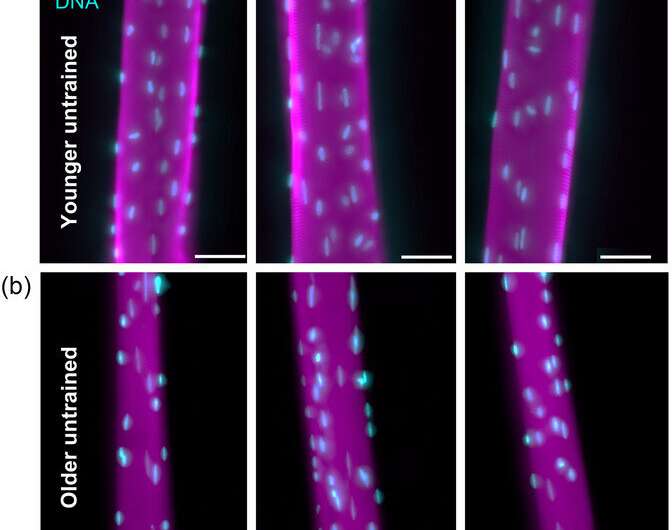This article has been reviewed according to Science X's editorial process and policies. Editors have highlighted the following attributes while ensuring the content's credibility:
fact-checked
trusted source
proofread
Muscle health may be informed by activity level rather than aging process

A new study comparing muscle structure between active and inactive people has found that older people who regularly do endurance exercise maintain similar muscle characteristics to younger counterparts.
Researchers learned that, when compared to inactive people, those who regularly do endurance exercise maintain muscle fiber size better. In older active people, the arrangement of muscle fiber nuclei, which act as the control centers for muscle tissue, was also more similar to younger counterparts.
Endurance exercise refers to any aerobic exercise sustained over an extended period of time that improves the endurance of the cardiovascular or muscular system. Examples include cycling, running, and even walking.
The study, published in Experimental Physiology and led by Dr. Matthew Stroud, Senior Lecturer at the School of Cardiovascular and Metabolic Medicine & Sciences, used advanced 3D microscopy imaging to analyze the structure of muscles.
Samples were taken from people who do and do not regularly do endurance exercise in both younger and older people for an analysis and comparison. For untrained individuals, the aging process affected muscle fiber size and the myonuclei. However, there was found to be zero correlation between aging and these aspects of the muscles for people who exercised.
These findings suggest that inactivity has a more pronounced effect on muscle fibers and myonuclear parameters than simply getting older. This means that if people stay active as they age, the size of their muscles are more likely to be maintained, and the distribution of myonuclei, which control muscle function, might not deteriorate as much as they would if they were inactive.
"Maintaining muscle fiber size, and control of the cell via myonuclei, might contribute to maintaining muscle function, which could be particularly beneficial as part of the body's response to the natural decline in muscle mass during aging. This may ultimately help to maintain the function of muscle into older age, thereby improving independence and quality of life," says Dr. Edmund Hugh Battey, former Ph.D. student in Dr. Stroud's lab at King's.
"The association between endurance exercise and these potential muscular benefits suggests a possible avenue for mitigating age-related muscle deterioration, though further research is necessary to fully understand this relationship."
By discovering a new potential mechanism in which exercise support healthy muscles, particularly into old age, the authors hope that it can help the scientific community understand how to maintain good muscle health as we get older.
More information: Edmund Battey et al, Muscle fibre size and myonuclear positioning in trained and aged humans, Experimental Physiology (2024). DOI: 10.1113/EP091567





















